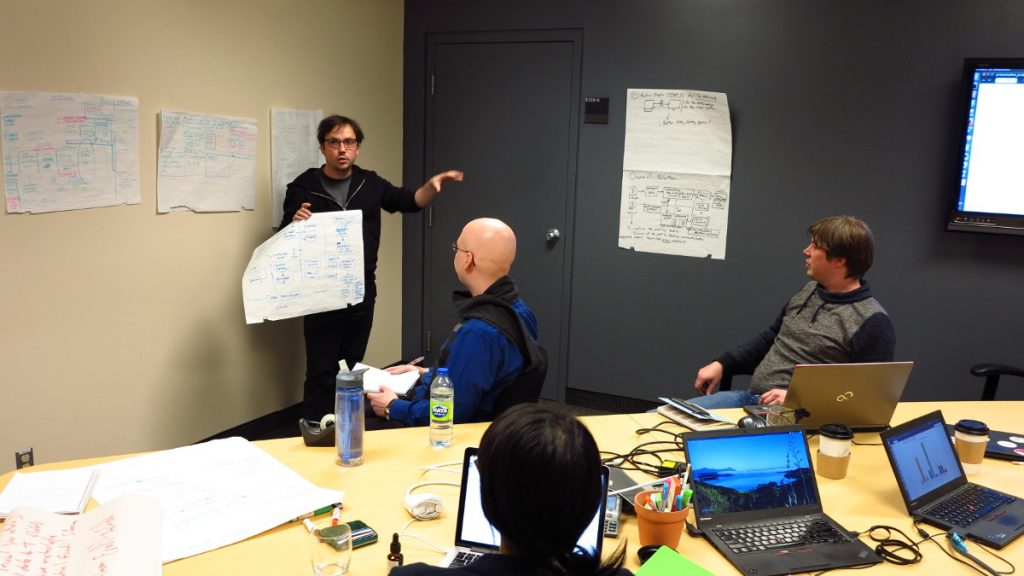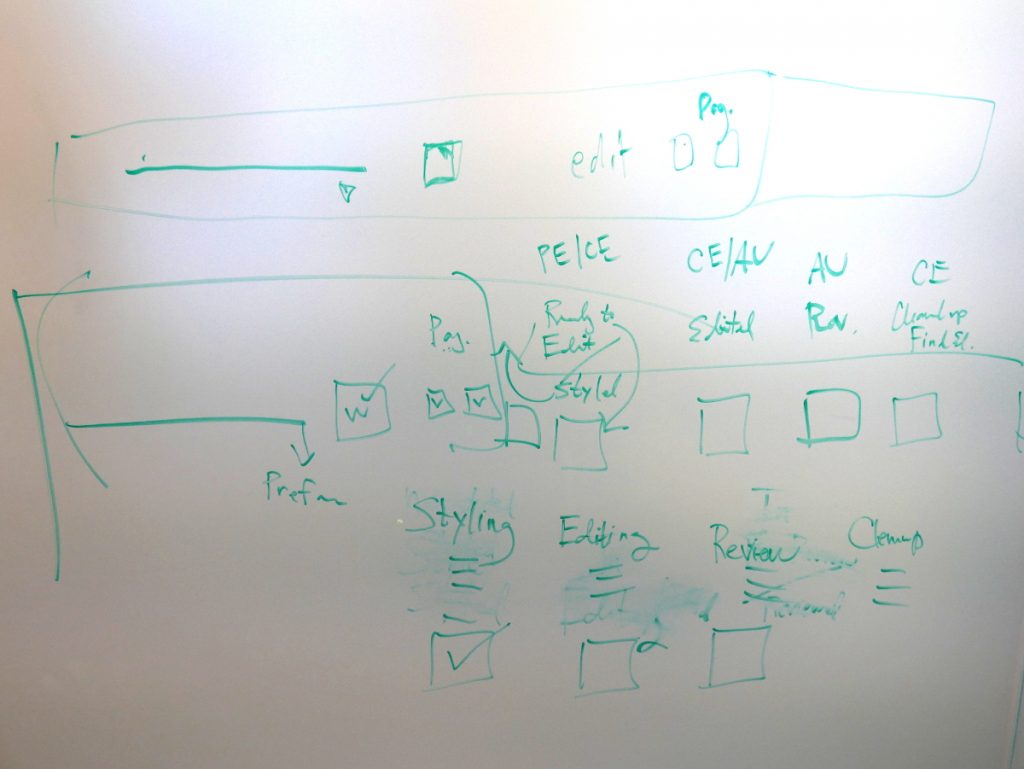The initial CPD design session starts with an initial current status review, followed by a development of a solution proposition, and finally a plan to produce part of that solution.
The following is a rough structure for a CDS implementation. Facilitation of CDS is necessarily fluid and it is not expected that there are strongly delineated phases, rather there will be some ebb and flow between each. As a rule, however, you should be moving forward through these stages in a somewhat sequential and linear fashion.
 Each of the following phases are guides and they may all be done in one CDS or over multiple sessions. The very first session has a special structure and we will get to that after describing the general approach:
Each of the following phases are guides and they may all be done in one CDS or over multiple sessions. The very first session has a special structure and we will get to that after describing the general approach:
Phase One – Why are we here?
Introductions
No matter if everyone knows each other, always do a round of introductions. It sets a baseline expectation that even the obvious should be stated. It will also help you to understand something of the stakeholders present and the roles they play. Experienced facilitators also use this time to read the interactions in the group and start formulating strategies to get them collaborating.
Why are we here?
Ask the question – do we want change? Before starting on any Collaborative Design Session you must first confirm that the group actually wants to produce change. This should be explicit, the facilitator can actually ask this question outright. The answer is yes, but it is not the answer that it is important, it is an affirmation by the group that they are prepared to undergo a process that will instigate change.
Phase Two – Where are we now?
Where are we now?
If the design session has materials to review from a previous session then this should occur now. If it is the initial session then we need a good understanding of the current workflow. Start with a description of the current workflow, identify pain points, quantify time periods, identify roles & gatekeepers. Turn all of these into easily consumable artefacts (may need to occur after the CDS) and share them.
 Example of an easily consumable current workflow description
Example of an easily consumable current workflow description
Identify Scope
The problem space identified above may be huge. If this is the case then some scoping is necessary. Ask the group to define the most important problems to solve first. If possible you want one nice cohesive problem to solve. Avoid trying to solve too much.
Phase Three – Where are we going?
This is when the group articulates what the future solution will look like. This can be a free ranging dreamy discussion but should be shaped slowly (like whittling wood) into something reasonable and achievable. This period might take some hours especially if it is the first session as there is much more to dream about earlier on.
Phase Four – Design
We are now in search of the Solution Proposition. An SP is not a solution, it is a proposition. It’s very important to frame it this way. We are not under the illusion that the final design is a magic cure-all, rather it is a hypothesis that we are now prepared to test out. There are a number of ways you can develop an SP. Your choice of method is a product of observations about how the team works together, the problems they are trying to solve, and your experience as a facilitator.

Here are some example methods to get there, these are some things that could work. However, facilitation is about invention. Invent processes like the below on the fly and then test them out in your sessions and learn. If you are doing your job well then you will be experimenting all the time, and if you are doing your job really well then no one will notice when one of your new inventions (possibly made up as you are saying it) fails. Those listed below work, but the first time I used each I made them up on the spot (shhh…).
- Blank Canvas
Start with a very open-ended session. Ask how they would like to work, let the conversation roam. Document anchor points that seem important and/or repeated themes. Essentially what you are looking for is a starting point for the new story on how things will be done. This starting point might be very concrete, or it might be highly conceptual. It could also be that you think you have the starting point but find that actually, some in the group want to take the starting point back to the fundamentals of what they are trying to achieve as an organisation. Your job is to witness this and keep the process going until you find the point where most, if not all, participants what to start the new story.At this point, you need to make sure the new story is well documented and you are getting good clear, simple, points. There is no substitute for facilitation experience at this point, but if you are struggling then the best strategy is to try and make the starting point somewhat concrete and less conceptual. For example, draw a blank box and say something like”how do we start the new process in a browser?” (assuming we are discussing web-based solutions). Get to a blank canvas that is somewhat parameterized and contained. Then draw out concrete details about what ‘could’ happen in on this new canvas. Enable people to roam and use what you have learned from the previous phases and what you know about the domain and product to ‘keep the conversation real’. This will make your work much easier.Iterate like this and work towards building concrete steps that illustrate the new ways of doing things. It is surprising that in some situations this process will lead directly to a pretty good understanding of what user interfaces and flow you are building. Other times you may need to keep the conversation going until something this concrete will materialise. In general, the more experienced you are as a facilitator the better this part of the process will proceed. - Pitching
Give each of the participants some large pieces of paper and ask them to each to draw a solution. Set a finite amount of time. Don’t let anyone claim they ‘don’t know enough’ about the problem space – ‘naive’ Solution Propositions often have very insightful points. At the end of the time limit, each participant is to pin their paper to the wall and speak to it in 5 minutes. These are not real pitches, just a light presentation of what they were thinking. Then have 5 minutes of questions and comments. Leave all papers on the wall (just add to them for every pitch). After everyone has presented it is good to break for a while as this was probably a long session. It is also good to break here to take some time and consider what your next step be. From the pitches, you must derive a single Solution Proposition. It is OK at this point to propose it yourself when the group returns to the room. Make sure when you do this you are proposing ideas that the group has had and not your own pre-designed solution. Invite comment on the Solution Proposition.You should end this phase with a good understanding of what cultural changes are necessary and what you are trying to build. It is not unusual to have whiteboard wireframes at the end of this process. - Give Them the Pen
Sometimes it is very useful to give someone with a strong vision for the solution a pen and ask them to draw it on a whiteboard and explain it. This turns the idea into something tangible that can then be discussed.

Phase Five – Summarise and Capture
This phase involves wrapping up the session, summarising what has happened and most importantly what is going to happen next. Capture all this ‘on paper’. The following is an example output of a whiteboard drawing of a component from one of these sessions:

In some instances, you need to clean up the outputs so others can better understand them. In this is a drawing that I made of it to make the idea clearer for the build team (see next chapter):

And, just an example, the following is an image of what the build team actually built:

Phase Sixth – Working Agreements
Agree on how you will work together. What channels you will use, what information goes where, when the next face to face or remote meetings will be etc.
The initial Design Session
The initial Collaborative Design Session is a little different. It requires the first phase to be a very deep dive into the way things are currently done and identifying the problem to be addressed and the scope. This will take a lot longer. Generally, a full day is required. Prepare to take the group through a longer and more involved ride and you should expect, and facilitate, a lot more discussion and spend a lot more time identifying shared semantics and understanding the exact details of what is now and where they want to go. It will be a long, but interesting, day.
